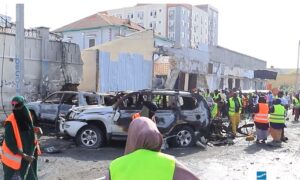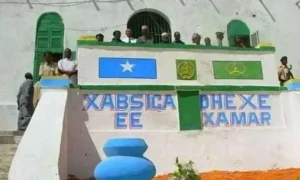28.03.2022: Mogadishu, Somalia
Somalia enters a transitional phase as the current AU mission in Somalia framework draws to a close following 15 years in the South of the country.
The African Union Mission has been involved in Somalia peace process for over a decade, having played a pivotal role in removal of Al-Shabaab from major towns and cities during the late 2000s and early 2010s including Mogadishu.
However, an important lesson to be learnt for international peacekeeping missions is that no matter how effective the military operations are, they cannot resolve the underlying political problems of the host nation with a magic-wand.
The reality is that even if a peacekeeping force militarily eradicates or drastically weakens a political or terrorist militia, it doesn’t eradicate the ideology or belief in itself meaning it can manifest itself in various different forms or locations.; a recurring issue at heart of the underbelly of that society.
It is more than just a war; it is societal issues that underpin raging conflict in many of these countries. It could be a result of:
- Poverty
- Inequality
Irrespective, it is for the locals to lead any form of reconciliation. It is for peacekeeping mission to provide that safe environment to allow discussions to happen.
We have seen this during the NATO/Western intervention of Yugoslavia which eventually saw all parties agree to a peace settlement in Dayton, Ohio.
However, the financial and political leeway obtained from participating countries means that the main objective of a mission is lost in the wind.
Take Uganda for example. President Museveni threatened to withdraw Ugandan troops from AMISOM if the UN insisted on reducing the number of troops or a reduction in funding. This is despite Uganda contributing the most amounts of soldiers in the AU mission.
Consequently, peacekeeping missions tend to elongate and stretch much longer than originally anticipated. For instance, the UN arrived in the southern Sudan in 2005. Similarly, the UN arrived in the Democratic Republic of Congo in 1999 yet neither have left.
Unfortunately, we see the same theme playing out in Somalia as the Somali government wrestles to regain the control it lost more than 30 years ago.
UN Statement
In a statement made, the UN Chief Guterres recommended to the UNSC that the AU ought to maintain its staffing level in Somalia through the end of the year. Guterres went on by saying that he prefers the gradual plan to reduce ATMIS in 4 phases to enable and support the Somali security forces to take primary responsibility for security in Somalia by the end of 2023.
He elaborated that under the plan, ATMIS first reduction of 2,000 troops would not happen until after December 2022, with more decreases in every phase until all ATMIS soldiers have departed by the end of 2023.
Interestingly, the letter written by Mr Guterres failed to outline the financing for ATMIS.
He wrote the following:
“I appeal to the international community to continue their support by providing adequate resources to ATMIS and Somali security forces, as well as through the provision of specialised capabilities”.
What is interesting about this is that the AU was seeking a hybrid model incorporating the UN which provided funding for the newly formed mandate.
Indeed if we look at AMISOM, the reasoning will become self-explanatory:
- Roughly 90% of the salaries of AMISOM units are paid by the EU and roughly 10% is paid by the UK government.
- In fact, since the EU’s APF was established in 2004, the EU has committed over €1.1billion to the AUPSC budget.
However, the Europeans have recently lost interest and faith in funding AMISOM for two main reasons:
- In the past 4 years, AMISOM have become ever more costly and ineffective.
- The Somali government wants AMISOM to leave as soon as possible as it rebuilds its security infrastructure.
As a result, the question of gaining large scale funding as seen with AMISOM will be difficult to answer.
Now aside from troops reduction and an end to the mandate written in stone, more positives have emerged:
- ATMIS will adopt the same unit boundaries as the SNA. It was in 2017 when the SNA sector boundaries were changed to match the new FMSs while AMISOM did not. As a result, at times, there would be an overlap of AMISOM & SNA divisions in various areas.
- Consequently, the distribution of soldiers did not represent the security needs of FMSs
Criticism
Nevertheless, many have criticised plans by the current Administration led by President Farmaajo to swiftly remove a peacekeeping mission from Somalia.
Some have pointed to the clashes that occurred in Mogadishu a year ago as evidence of division while others have pointed out the fact that Al-Shabaab remains a major threat not just in Somalia but the wider global.
Indeed, Al-Shabaab is a threat to East Africa and is an umbrella of the international terrorist group Al-Qaeda. However, as I have mentioned earlier, conflicts such as the one in Somalia is not just simply international terrorism and eradication of terrorists.
Of course these are important elements, but the most important is dealing with the problems faced by those young men and women that join Al-Shabaab due to hardship faced in their own lives.
Many young Somalis that live in the countryside and more secluded areas are more susceptible to terrorist propaganda for two of the following reasons:
- Many do not have access to proper education and as a result have a limited grasp of the religion and law.
- Many face financial hardship and consequently are more inclined to join Al-Shabaab if given financial incentives.
Additionally, many ethnic minorities might feel more inclined to accept governance from Al-Shabaab than anarchy as they are more susceptible to racist or discriminatory actions that disproportionately affected due to their clan or origins.
Take the Somali Bantu people for example. The severity of abused faced by these Somalis forced the US to classify Somali Bantu refugees from Somalia as a high priority. Over a 4 year period, up to 30,000 Somali Bantus were resettled from refugee camps in Kenya to the United States by 2004.
The point I am trying to raise here is that many are more inclined to accept Al-Shabaab rule in exchange for this illusion of peace provided by the draconian iron rule of the terrorist group.
In essence, there remains a power vacuum in Somalia as the Somali state attempts to spread itself across the territories of Somalia which had been stateless for far too long. This absence of the state renders the state’s security & legal apparatuses obsolete. Many have relied on non-state actors, whether it is clan elders or a militia group.
Regardless, a light at the end of the tunnel is getting closer and closer. The regaining of the narrative by the Somali government against the AU is a major step forward in its journey to effective statehood both domestically and internationally. A stamped end date and continued central role that the Somali security forces will play in the security of the Somali Republic is a major achievement by this government, not seen since 1989.
However, there remain underlining issues aside from security before we can see a fully functioning democratic state in Somalia:
- The enforcement of direct democracy. This can be cemented by the amendment of the constitution to only allow direct elections in the country. Nothing less.
- The completion of the Constitution as this provisional constitution has been in place since 2000.
- It remains the major hindrance to governmental stability btw the PM & President.
- The completion of the Supreme Court to be the only adjudicator of the Somali constitution. A court respected and followed by all Somali and non-Somali acting in Somalia.
For regular updates on Somalia follow Suldan Mohamed and Horufadhi Media on Social Media.







